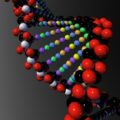
Concerns about the biological safety of nanotechnology are increasing voiced by the medical community, but Euro researchers say that their experiments with rats show that the brain can effectively deal with any bits of nanowaste that might find their way there. Their work appears in the journal Nano Letters.
The researchers, from Lund University in Sweden, looked specifically at nanowires which were injected into the brains of rats. It is widely anticipated that such nanowires will be used in the future in conjunction with nanoscale electrodes to treat patients suffering from chronic pain, depression, and diseases such as Parkinson’s. Electrodes are already used today to counteract symptoms of Parkinson’s disease and future nanotechnology may enable refined and enhanced treatment and pave the way for entirely new treatments.
The new experiments looked at what might happen if those nanowires break and are released into the brain. To do this, the scientists produced nanowires that were then mixed into a fluid that was injected into the rat brains. An equal number of rats were given the solution without the nanowires. After 1, 6, and 12 weeks, respectively, the researchers looked at how the rat brains were reacting to the nanowires.
“We studied two of the brain tissue’s support cells: on the one hand, microglia cells, whose job is to ‘tidy up’ junk and infectious compounds in the brain and, on the other hand, astrocytes, who contribute to the brain’s healing process. The microglia ‘ate’ most of the nanowires. In weeks 6 and 12 we could see remains of them in the microglia cells,” added co-researcher Nils Danielsen.
The study notes that the number of nerve cells remained constant for test and control groups, the greatest difference being that the former had a greater astrocyte reaction at one week, but this level eventually declined. At weeks 6 and 12 the scientists were not able to detect any difference at all. “Together with other findings and given that the number of microglial cells decreased over time, the results indicate that the brain was not damaged or chronically injured by the nanowires,” concluded Prinz.
Related:
Nanoparticle Laced Wastewater Could Compromise Treatment Plants
Nanotech Gone Bad: Who You Gonna Call?
Nanotech Challenges Identified
From Little Things, Big Conundrums Grow








Comments are closed.